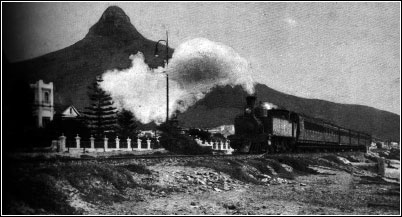A historical investigation into the Sea Point beachfront as a public open space throughout the 20th century with special reference to memories of growing up along the Sea Point Promenade by Leila Emdon.
Chapter Two continued – The growth of a suburb: the Development of Sea Point in the late 19th century to the 1950s
<< previous Chapter Two The growth of a suburb
Availability of public transport
Sea Point can be split into two main roads. The Beach Road runs between the promenade and the flats and hotels that are opposite. Before the 19th century, there was no such road but, instead, the road as we know it today was part of people’s large gardens.
Behind the flats is another road called Main Road. This is where the business of Sea Point happens. Most schools, churches and synagogues are situated here. The number of properties grew during the first half of the nineteenth century, as more roads were built. Most development occurred between the Main and Beach Roads until the mid nineteenth century.
Although the area was sparsely populated, development began to speed up in the second half of the century. A horse drawn omnibus was provided. A tram assisted it in 1862. The provision of transport made the Green and Sea Point the first commuter suburb. This made easier the increase in 5 M, Murray, 1964 Under Lions Head, A.A Balkema pg 7 6 ibid population that could be now be supported. The introduction of the railway in 1892 made accessibility easier. For people growing up in Sea Point during this time, the changes were welcomed.
Many young people used to marvel at the tram going past the Main road. Joe remembers watching the tram go past his house on the main road of Sea Point. Transport availability made it easier for people to travel. The low crime rate meant that young people could walk to and from school, as well as to friends. It is hard to imagine now that where the lawns are along the beachfront there was once a railway. There are not many people alive today who used the train. The two trains were failures from the start as could not take the curves without being derailed, and both, too, were prone to regular breakdowns.7
Beneath the Lion Bold describes the opening of the second train line: “November 30, 1905, was a big day for the Green and Sea Point community, especially the school children, to whom a puffing steam-train was the fastest thing on wheels and a really exciting spectacle. The railway, ‘which for several years had been an abeyance’, was reopened. It had been taken over by the Government Railways, rebuilt and regarded and extended to the end of Sea Point.”8
A Train of the “second railway” approaches Bordeaux on its way to Cape Town in 1915 Photo: Under Lions Head
Although the rail was well patronised in the beginning, the Tramway Company, running trams along the Main road began competing with the market by improving their lines and decreasing their prices. For fourteen years, the train ran at a loss.9 In addition, on the 16th of April 1929 the last train ran. Although a failure, the train is remembered as a distinguished aspect of the promenade’s history.
As Joe Mauerberger exclaims, “As you know, we had a railway e. It left at the station, came all along past the pavilion, and ended by the Aquarium. It went along where the lawns are today, tunnels were there to get to the beach. This ended in 1929, because most people lived above the beachfront unlike today. Today it would do very well.”10 Today a memorial for the train is found on the Three Anchor Bay side of the promenade.
7M, Murray, 1964 “The two Railways”, in Under Lions Head, pg 89 8 C, Lighton (Ed), 1963, “A Railway Occasion”, in Beneath the Lion Bold- A story of Green and Sea Point, Rustica Press Cape Town pg 50 9 M, Murray, 1964 “The two Railways”, in Under Lions Head, pg 89 10Joe Maureberger, 31st August 2008, recorded interview
<< previous Chapter Two The growth of a suburb —- Old Hotels, Estates of the Beach Rd and Main Rd Area next >>

